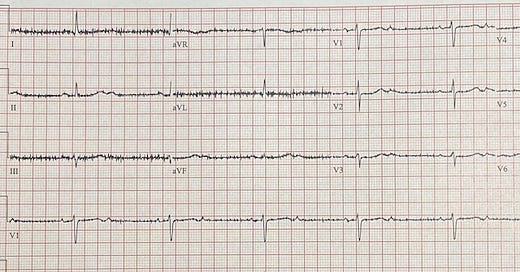Make Sure That "Sinus Bradycardia" is not 2 to 1 AV Nodal Block
One of My First Lessons as a Young Clinician
It was 1978 and I had been reading ECGs (electrocardiograms) for profit for the first time as a new attending on the faculty at Brown University. I was working at Pawtucket Memorial Hospital in Rhode Island which has since closed. There was a cardiologist there named Edwin Lovering (1916–2004) who was ancient (age 62) by my standards at that time. I had read an ECG the previous day as "sinus bradycardia” with a heart rate of 40 beats per minute. Dr. Lovering sought me out and gently said something like, "Paul, whenever you see slow sinus bradycardia, divide the visible P wave interval in half and look for P waves that you missed". He then showed me that my diagnosis of sinus bradycardia was actually 2 to 1 heart block. That was a great lesson that has saved me from making the same mistake many times over the last 47 years.
Above are ECGs from a patient I saw in the last two weeks while on hospital consult service. The first ECG was read by the computer and signed by the cardiologist as “sinus bradycardia”. The second ECG has the P waves circled. This shows that the tracing is really 2 to 1 heart block. It is not possible to say whether the block was in (Mobitz type I) or below (Mobitz type II) the atrial-ventricular (AV) node since it’s 2 to 1 block, but a subsequent ECG showed complete AV heart block. She received a pacemaker.
I could never remember the difference between Mobitz type I and type II block. The way I remember is that murder in the first degree is the worst, but that Mobitz I is the first degree, but is less worrisome than Mobitz II (the second degree) so you don’t go to cardiologist’s jail if you miss the first degree (for Mobitz I). Mobitz I is also called Wenckebach block. Mobitz II is more worrisome than Mobitz I because if complete heart block occurs, the escape rhythm is often slower in Mobitz II.
I would like to tell you a little bit more about Dr. Lovering. He went to Brown University undergraduate and then to Tufts medical school. (Tufts is where all the great ones go; Harvard is where they go when they can’t get into Tufts.) Ed graduated from Tufts in 1942. He then spent 3 years in the Navy during World War II in both the European and Pacific theaters. His ship participated in the D-day landing. In the Pacific his ship was hit by a kamikaze plane. Ed received a letter of commendation for his valor in caring for the wound during that event.
I remained grateful to him for his lesson.
So, here are the rules:
- Whenever you see severe “sinus bradycardia” make sure it’s not 2 to 1 heart block.
- Mobitz I or “in the first degree” is not as worrisome as Mobitz II, despite the name,.
- You can make other clinicians, and thereby medical care, better by teaching.
#heartblock #ECG #cardiology #medicine







Thank you for the amazing article!